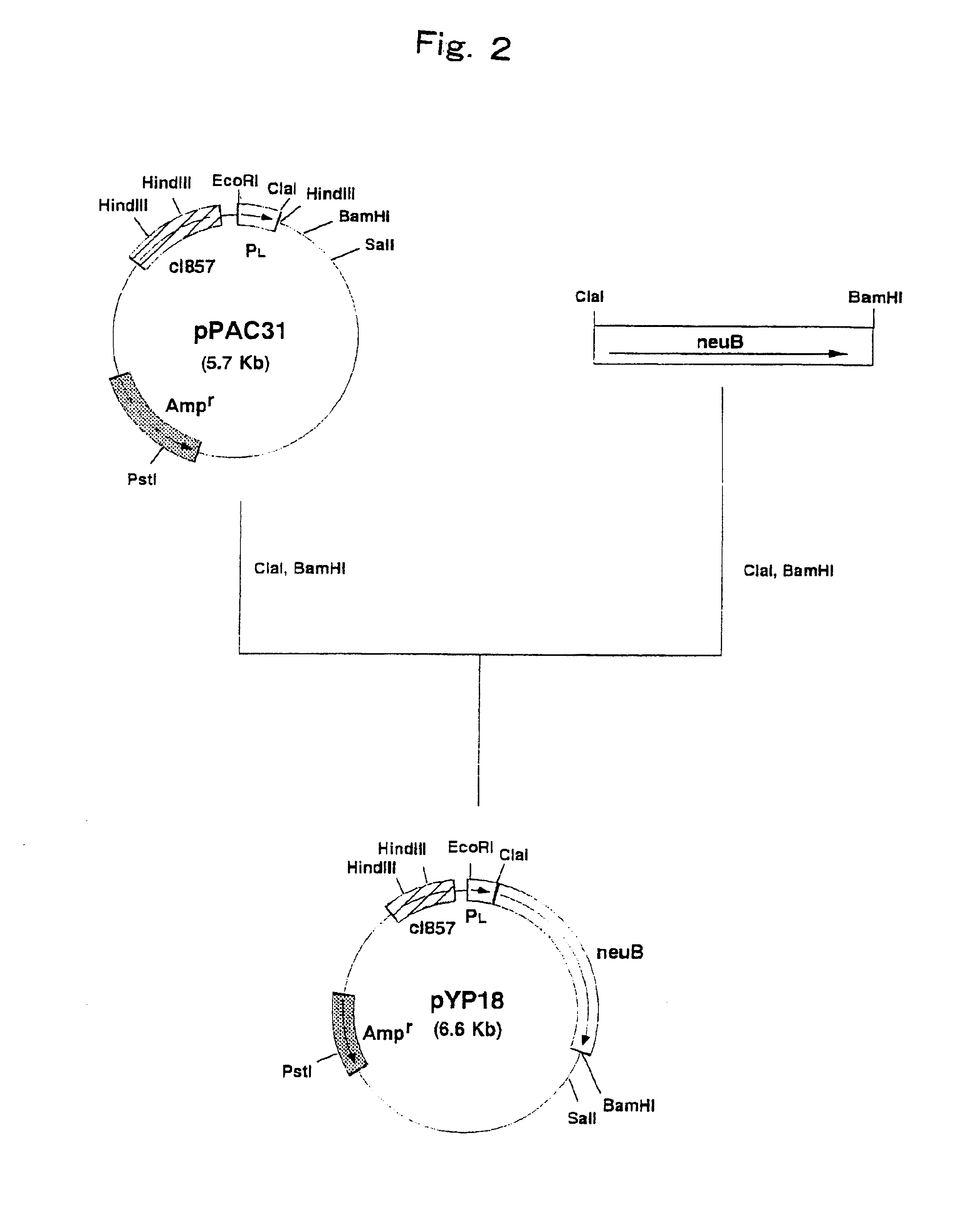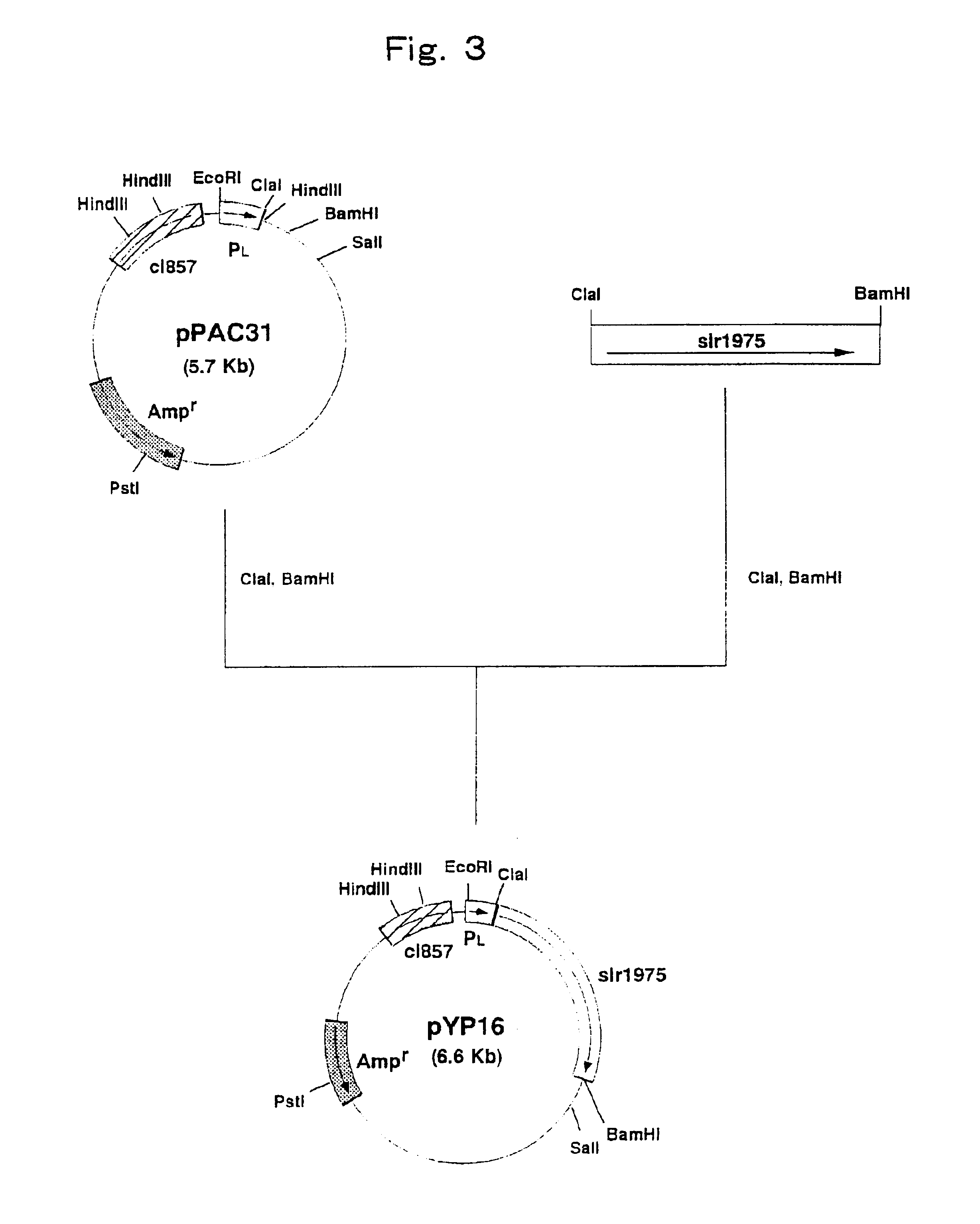Process for producing N-acetylneuraminic acid
a technology of n-acetylneuraminic acid and process, which is applied in the direction of enzyme stabilisation, transferase, lyase, etc., can solve the problems of no economic method for producing n-acetylneuraminic acid, and no report describing or suggesting the production of n-acetylneuraminic acid, etc., and achieves the effect of efficient production
- Summary
- Abstract
- Description
- Claims
- Application Information
AI Technical Summary
Benefits of technology
Problems solved by technology
Method used
Image
Examples
example 1
[0094]Construction of a Strain Expressing N-Acetylneuraminic Acid Aldolase Gene Derived from Escherichia coli
[0095]Escherichia coli W3110 (ATCC 27325) was cultured by the method described in Current Protocols in Molecular Biology and the chromosomal DNA of the microorganism was isolated and purified.
[0096]The DNA primer shown in SEQ ID NO: 3 and the DNA primer shown in SEQ ID NO: 4 were synthesized by using a DNA synthesizer (Model 8905, PerSeptive Biosystems).
[0097]PCR was carried out using the above synthetic DNAs as primers and the chromosomal DNA of Escherichia coli W3110 (ATCC 27325) as a template. That is, PCR was carried out by 30 cycles, one cycle consisting of reaction at 94° C. for one minute, reaction at 42° C. for 2 minutes and reaction at 72° C. for 3 minutes, using 40 μl of a reaction mixture comprising 0.1 μg of the chromosomal DNA, 0.5 μmol / l each of the primers, 2.5 units of Pfu DNA polymerase (Stratagene), 4 μl of buffer for Pfu DNA polymerase (10×) (Stratagene) a...
example 2
[0102]Production of N-Acetylneuraminic Acid
[0103]Escherichia coli NM522 / pTA3 obtained in Example 1 was inoculated into 125 ml of LB medium containing 50 μg / ml ampicillin in a 1-l Erlenmeyer flask with baffles, followed by culturing at 28° C. with stirring (220 r.p.m.) for 17 hours. The resulting culture (125 ml) was inoculated into 2.5 l of a liquid medium (pH unadjusted) comprising 10 g / l glucose, 12 g / l Bacto-tryptone (Difco Laboratories Inc.), 24 g / l yeast extract (Difco Laboratories Inc.), 2.3 g / l KH2PO4, 12.5 g / l K2HPO4 and 50 μg / ml ampicillin in a 5-l jar fermentor. Culturing was carried out at 37° C. for 6 hours under the conditions of stirring at 600 r.p.m. and aeration at 2.5 l / min. During the culturing, the pH of culture was maintained at 7.0 with 28% aqueous ammonia. Glucose was added, according to need, in the course of culturing. The resulting culture was centrifuged to obtain wet cells. The wet cells could be stored at −20° C. and could be used after thawing, according...
example 3
[0106]Construction of a Strain Expressing N-Acetylneuraminic Acid Synthetase Gene Derived from Escherichia coli
[0107]Escherichia coli K235 (ATCC 13027) was cultured by the method described in Current Protocols in Molecular Biology and the chromosomal DNA of the microorganism was isolated and purified.
[0108]The DNA primer shown in SEQ ID NO: 5 and the DNA primer shown in SEQ ID NO: 6 were synthesized by using a DNA synthesizer (Model 8905, PerSeptive Biosystems).
[0109]PCR was carried out using the above synthetic DNAs as primers and the chromosomal DNA of Escherichia coli K235 (ATCC 13027) as a template. That is, PCR was carried out by 30 cycles, one cycle consisting of reaction at 94° C. for one minute, reaction at 42° C. for 2 minutes and reaction at 72° C. for 3 minutes, using 40 μl of a reaction mixture comprising 0.1 μg of the chromosomal DNA, 0.5 μmol / l each of the primers, 2.5 units of Pfu DNA polymerase (Stratagene), 4 μl of buffer for Pfu DNA polymerase (10×) (Stratagene) a...
PUM
| Property | Measurement | Unit |
|---|---|---|
| concentration | aaaaa | aaaaa |
| pH | aaaaa | aaaaa |
| pH | aaaaa | aaaaa |
Abstract
Description
Claims
Application Information
 Login to View More
Login to View More - R&D
- Intellectual Property
- Life Sciences
- Materials
- Tech Scout
- Unparalleled Data Quality
- Higher Quality Content
- 60% Fewer Hallucinations
Browse by: Latest US Patents, China's latest patents, Technical Efficacy Thesaurus, Application Domain, Technology Topic, Popular Technical Reports.
© 2025 PatSnap. All rights reserved.Legal|Privacy policy|Modern Slavery Act Transparency Statement|Sitemap|About US| Contact US: help@patsnap.com



